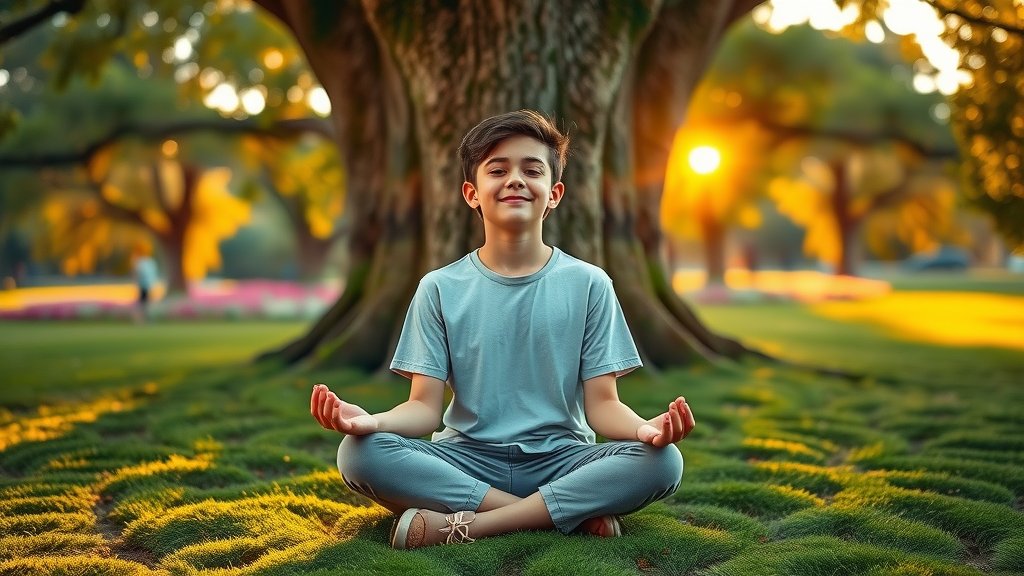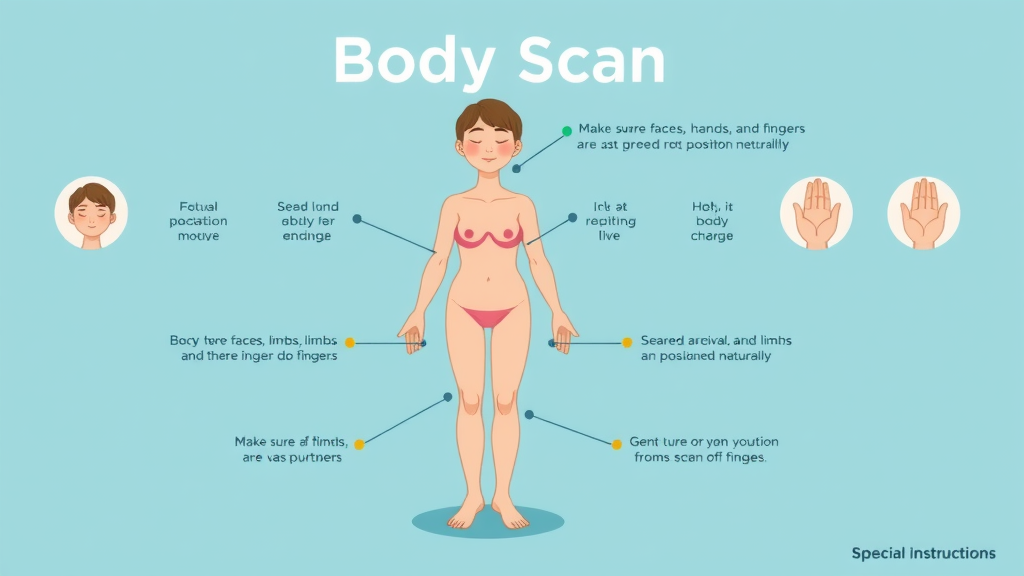Did you know that over 70% of teenagers feel overwhelmed by stress at times? With pressures from school, social life, and the digital world, it's no surprise that many teens find it hard to stay calm and focused. But there’s good news: mindfulness and relaxation for teens can make a real difference, transforming mental health and everyday life with simple yet powerful habits. In this guide, you’ll discover practical tools and the science behind why these techniques work, empowering both teens and those who support them.

Startling Teen Mental Health Statistics: Why Mindfulness and Relaxation for Teens Matter
Teen mental health challenges are at an all-time high. According to the National Institute of Mental Health, over 70% of teenagers report experiencing overwhelming stress or anxiety, and rates of depression have climbed steadily among school students. In today's fast-paced society, the constant barrage of notifications, academic expectations, and social comparisons make it harder for teens to pay attention to the present moment. This mounting pressure heightens the risk of long-term impacts on mental health, academic performance, and relationships.
The urgency is clear—mindfulness and relaxation for teens are not just “nice-to-haves,” but essential tools. By practicing mindful breathing and other mindfulness exercises, teens can learn to calm their minds, reduce stress, and increase their ability to pay attention, resulting in stronger mental health and a more balanced view of everyday life. These techniques are easy to learn, effective, and supported by scientific evidence showing improvements in executive function, emotional regulation, and overall well-being.
“Over 70% of teenagers report sometimes feeling overwhelmed by stress, making mindfulness and relaxation for teens more crucial than ever.” – National Institute of Mental Health

What You'll Learn About Mindfulness and Relaxation for Teens
The science behind mindfulness and mental health for teens
Simple mindfulness exercises and relaxation techniques for beginners
How to integrate mindfulness activities into everyday life
Ways to use guided meditation and body scan exercises
Tips for teaching mindfulness and practice mindful habits
FAQs and actionable advice for parents and educators
Understanding Mindfulness and Relaxation for Teens: A Foundation for Positive Mental Health
Mindfulness and relaxation for teens start with understanding what it means to be present and aware. At its core, mindfulness is the practice of paying close attention to the present moment, intentionally and without judgment. It’s about noticing thoughts, feelings, and physical sensations without letting them overwhelm you. For many teens, learning mindfulness activities and relaxation exercises can be transformative—offering ways to control racing thoughts, reduce stress, and cope with life’s hurdles.
When teens practice mindfulness, they develop resilience and self-care habits that support mental health, relationships, and academic success. Whether it’s through mindful breathing, guided meditation, or simple mindful eating, these techniques empower teens to manage stress and appreciate everyday life with renewed clarity. Ultimately, mindfulness and relaxation for teens lay a strong foundation—helping teens thrive emotionally, academically, and socially.

What Is Mindfulness and Why Practice Mindfulness?
Mindfulness means focusing your attention on the here and now—on your breath, your surroundings, or your thoughts—without judging yourself or getting lost in worries. For teens, practicing mindfulness can mean simply noticing the cool air during a walk or pausing before reacting to a stressful situation. Learning mindfulness exercises helps teens develop the ability to “pause and reset,” a powerful skill for reducing anxiety and balancing emotions. Mindfulness activities for teens are designed to be simple, engaging, and suitable for daily use. The benefits of mindfulness go far beyond stress management: research shows that practicing mindfulness can improve focus, increase self-esteem, and foster stronger connections with others.
Teens who practice mindfulness regularly often find it easier to cope with academic pressure, social expectations, and even conflict with peers. The practice mindful process teaches them to notice their thoughts without getting swept away, helping them become less reactive and more deliberate in everyday life. Mindfulness and relaxation for teens act as a toolkit—one that teens can reach for any time they need to reduce stress, spark creativity, or ground themselves in the present moment.
Mental Health and Stress in Teens: The Growing Need for Mindfulness Activities
Teens today navigate a unique landscape of academic performance pressures, social comparison via social media, and the high expectations of parents and teachers. All of these factors contribute to high rates of stress, anxiety, and even depression among adolescents. Mental health struggles can make it hard to concentrate, get enough sleep, and connect meaningfully with others. This is where mindfulness activities for teens play a pivotal role—they offer teens practical, science-backed relief tools at their fingertips.
By engaging in mindfulness exercises like guided meditation, deep breathing, or body scan practices, teens learn simple steps to calm their nervous system and self-regulate their emotions. With regular mindfulness training, stress becomes easier to manage and negative thoughts or feelings have less control over mood and behavior. In short, the growing need for mindfulness and relaxation for teens stems directly from the demands of modern teen life—these skills are no longer optional, but vital to mental health and overall resilience.
The Science: How Mindfulness and Relaxation Impact Mental Health in Everyday Life
Many scientific studies support the benefits of mindfulness for young people. Mindfulness practices activate parts of the brain responsible for attention, emotional regulation, and empathy. By practicing mindfulness, teens show improvements in memory, executive function, and even immune response. A key reason for these wide-ranging benefits is that mindfulness helps teens feel more grounded in the present moment—shifting focus from ruminating on the past or worrying about the future to appreciating what’s happening right now.
Regular mindfulness training, including guided meditation and mindful breathing, has been shown to reduce symptoms of anxiety and depression in adolescents. Teens who practice mindful activities typically have lower cortisol (the stress hormone) levels and improved sleep patterns. In everyday life, this means better performance at school, improved relationships with friends and family, and a stronger sense of self-worth.
Comparing Stress Reduction Techniques: Mindfulness Training vs. Other Approaches (Researched Benefits for Teens)
Technique |
Benefits for Teens |
Ease of Use |
Lasting Effects |
|---|---|---|---|
Mindfulness Training |
Reduces anxiety, strengthens focus, improves mood, enhances executive function, fosters resilience |
Easy to learn; can be practiced anywhere |
Proven long-term positive changes in mental health and emotional wellbeing |
Basic Relaxation Techniques |
Calms immediate stress, aids relaxation |
Simple; requires minimal guidance |
Short-term relief; does not build deep coping habits |
Cognitive Behavioral Strategies |
Effective for anxiety and depression, teaches thought management |
Needs trained support or guidance |
Strong long-term effects when combined with mindfulness |
Physical Activity |
Reduces stress, improves mood, boosts energy |
Accessible; requires motivation |
Benefits last as long as activity is regular |
Top Benefits of Mindfulness and Relaxation for Teens
The benefits of mindfulness and relaxation for teens are profound and wide-reaching. Teens who consistently engage in mindfulness practices experience a dramatic reduction in anxiety and stress—common obstacles in school and social life. Research also shows that mindful breathing and regular mindfulness exercises lead to improved concentration, enhanced self-awareness, and stronger academic performance. These skills build a foundation that supports both mental health and emotional agility.
Beyond reducing stress, practicing mindfulness teaches teens to notice their emotions as they arise. This helps with healthier emotional regulation and promotes a growth mindset, where mistakes become opportunities for learning. Mindfulness activities, like mindful eating and walking, foster present moment awareness and deepen self-care habits—equipping teens to handle the ups and downs of everyday life with greater calm and confidence.
Reduces anxiety and stress in mental health
Improves focus and academic performance
Strengthens emotional regulation
Promotes mindful breathing, present moment awareness, and self-care
“Mindfulness activities help teens pause, breathe, and notice: essential skills for thriving in today’s fast-paced world.” – Mindfulness Expert

Mindfulness Activities for Teens: Easy Ways to Start Practicing Mindfulness
Embarking on the journey of mindfulness and relaxation for teens doesn’t require special tools or long stretches of free time. Simple, accessible activities can be incorporated into everyday life, bringing calm within reach—whether at home, at school, or on the go. These mindfulness activities for teens are designed to be flexible, engaging, and appropriate for beginners or those ready to deepen their practice.
From mindful breathing and quick body scans to brief guided meditations, every activity is structured to help teens slow down, connect with their senses, and reduce anxiety. By exploring different techniques, teens find which practices resonate most and fit naturally into their routines. The following exercises and tips are an excellent starting point for any teen interested in gaining focus, balance, and self-care skills.
Mindful Breathing: The Simplest Mindfulness Exercise
Mindful breathing is the cornerstone of mindfulness practice; it’s easy, effective, and can be done anywhere. By focusing attention on each breath—inhaling and exhaling slowly—teens activate their parasympathetic nervous system, which helps reduce stress and ground them in the present moment. The best part? It takes just a minute or two, making it an ideal tool for busy school students or anyone needing a pause in a hectic day.
To begin, sit comfortably with your back straight, close your eyes if you like, and notice your breath moving in and out. If your mind starts to wander, gently bring your focus back to each inhalation and exhalation. Practicing mindful breathing regularly not only soothes anxiety but also teaches teens to recognize and respond calmly to stress. This mindfulness exercise is a powerful first step in building emotional resilience and self-awareness.

Explore simple breathing techniques for relaxation
Tips for guiding teens in mindful breathing
Quick Mindfulness Exercises and Relaxation Techniques Teens Can Practice Anywhere
Teen schedules are busy, but quick mindfulness exercises can deliver big benefits in short bursts. Two favorites among health experts and school counselors are the 3-minute body scan and the 5-4-3-2-1 grounding activity. The body scan is a mindfulness practice where you “scan” your body from head to toe, noticing sensations without judgment. The 5-4-3-2-1 activity helps anchor you to the present moment by naming things you sense around you—sight, sound, touch, smell, and taste.
These methods are especially helpful for reducing anxiety before tests or calming nerves during stressful social situations. Taking a mindful pause for just a few minutes improves clarity and composure. Teens can easily weave these mindfulness exercises into their day—right before class, during study breaks, or even on the school bus.
3-minute body scan mindfulness exercise
The 5-4-3-2-1 grounding mindfulness activity

Incorporating Mindfulness Practice Into Everyday Life
Practicing mindfulness doesn’t have to be separate from routine activities—it works best when woven into daily life. For example, a teen might focus on the feel, taste, and sensation of food during mindful eating or notice each step and breath during a walk across campus. Other strategies include short check-ins before homework, mindful listening in conversations, or gentle stretches between classes.
The goal is to pay attention to the present moment as often as possible. Even a few seconds of tuning in can shift mood and increase awareness. By anchoring mindfulness activities to existing habits (like brushing teeth or waiting for the bell to ring), teens can build reliable, sustainable mindfulness practices that support mental health every day.
Ideas for practicing mindfulness during daily routines
Mindful eating and mindful walking
Watch: Short Guided Meditation for Teens—see mindfulness practice in action!
Teaching Mindfulness and Mindfulness Exercises: Guidance for Parents and Educators
Teaching mindfulness requires patience and creativity, but the rewards for both teens and adults are considerable. Parents, teachers, and counselors can introduce mindfulness activities to support mental health and resilience in young people. It’s important to create an environment that feels safe, open, and stigma-free—encouraging exploration and curiosity without pressure.
Simple prompts, like asking teens to “notice one thing they hear right now” or guiding them through a short guided meditation, can ease them into the practice. Educators can also weave mindfulness exercises into classroom transitions, group work, or test preparation. Consistent support and modeling from trusted adults make mindfulness more relatable and sustainable for teens.
How to Create a Quiet Place for Mindfulness Practice
A quiet place is ideal for mindfulness practice, especially when a teen is just starting out. This could be a comfortable corner in a bedroom, a cozy nook in the family room, or a special seat in the classroom. It helps to have soft lighting, cushions, or even calming objects like plants or candles—anything that signals a calm space for mindful activities.
Parents and teachers can encourage teens to personalize their space, ensuring it is free from distractions like phones or TVs. By making this area accessible and inviting, teens are more likely to associate mindfulness exercises and guided meditation with comfort, support, and relaxation.

Best Mindfulness Training Methods and Mindfulness Activities for Teens
There is no one-size-fits-all when it comes to mindfulness training for teens. Some enjoy moving meditations like mindful walking or yoga, while others benefit from quiet reflection, mindful breathing, or guided meditations. Group mindfulness activities, such as body scan exercises led by teachers or peer mentors, create a sense of support and accountability in schools.
The best approach is to offer a variety of mindfulness exercises so that each teen can find what feels natural to them. Experimentation and shared experiences make it easier for teens to learn mindfulness, build confidence, and stick with their new habits.
Using Guided Meditations and Body Scan Practices to Support Teen Mental Health
Guided meditation is especially helpful for teens who are new to mindfulness. By following a teacher’s or audio instructor’s voice, teens can immerse themselves in relaxation without worrying about “doing it right.” A body scan mindfulness exercise guides attention to different areas of the body, helping release tension and increase body awareness.
When practiced regularly, these tools offer ongoing support for teen mental health, lowering stress, increasing mindfulness in daily life, and strengthening emotional resilience. Apps, online videos, and community groups are excellent resources to support teens as they discover what works best for them.
“Teaching mindfulness isn’t about eliminating problems, but equipping teens with tools to handle them resiliently.” – School Counselor

Watch: Demonstration of Teaching Mindfulness and Guided Meditation for Teen Relaxation.
Overcoming Challenges: Common Barriers to Mindfulness and Relaxation for Teens
Even with so many proven benefits of mindfulness, some teens resist mindfulness activities. Barriers range from skepticism (“this won’t work for me”) to perceived lack of time or fear of judgment from peers. Addressing these roadblocks requires honesty and understanding: many teens want quick fixes and may feel frustrated if results are not immediate.
Teachers and parents can normalize these feelings, discuss them openly, and share their own experiences with mindfulness. By framing mindfulness and relaxation for teens as life skills—not chores—adults can foster curiosity and reduce resistance.
Why Some Teens Resist Mindfulness Activities
Skepticism is common—especially if a teen associates mindfulness with “boring” or “uncool” practices. Others worry they won’t be able to focus, or they fear criticism from friends. Educators can help by explaining the science behind mindfulness, sharing stories of real teens who’ve benefited, and introducing activities in a low-pressure way.
Allowing teens to choose how and when to engage in mindfulness activities for teens is key to building buy-in. When they feel respected and empowered, they’re more likely to give mindfulness training an honest try.
Addressing Distractions and Maintaining Practice Mindful Habits
Distractions like phones, social media, and homework make it easy to slip out of mindfulness routines. Setbacks are normal, but simple strategies can boost consistency—setting daily reminders, having an accountability buddy, or linking practice to an existing activity (like listening to music or walking home from school).
Ultimately, the goal is to practice mindful habits without guilt or perfectionism. Small, persistent efforts add up. Celebrate progress, and remind teens that mindfulness is a lifelong journey, not a race.

Setting realistic expectations
Strategies for sustaining mindfulness exercises over time
People Also Ask: Mindfulness and Relaxation for Teens
What Are the Best Mindfulness Exercises for Teens?
The best mindfulness exercises for teens include mindful breathing, body scan, guided meditation, and the 5-4-3-2-1 grounding activity. These are easy to learn and can be practiced almost anywhere—whether at home, in school, or outside. For busy teens, even one minute of focused, mindful breathing can soothe anxiety and sharpen attention. Many teens also enjoy practicing mindfulness by integrating activities into daily life, such as mindful eating or walking, which reinforces present moment awareness with little effort.
How Can Mindfulness Help with Anxiety and Stress in Teens?
Mindfulness and relaxation for teens provide practical, evidence-based ways to manage anxiety and stress. By anchoring attention to the present moment and focusing on breath, teens reduce the “fight-or-flight” response that triggers anxiety. Over time, regular mindful practice helps teens build emotional resilience, recognize their stress triggers, and respond more calmly in difficult situations. These coping tools are especially powerful in reducing the impact of stress on relationships, academics, and overall well-being.
Can Mindfulness Practice Be Integrated into School Routines?
Absolutely. Mindfulness activities can easily fit into a school’s daily schedule. Teachers might start class with a minute of deep breathing, offer a mindful listening activity before tests, or encourage mindful walking during breaks. Many school students benefit from mindfulness clubs or workshops. Integrating mindfulness into routines helps reduce stress, support mental health, and improve focus for learning.
How Long Does It Take for Teens to Notice Benefits of Mindfulness and Relaxation?
Teens often notice positive changes after just a few sessions of mindfulness practice—feeling calmer, sleeping better, or handling challenges with greater ease. However, lasting benefits develop over time with regular practice. Experts recommend starting small (a few minutes each day) and gradually building up to longer periods. Consistency is more important than duration, and even short daily mindfulness exercises can deliver meaningful results.
Expert Tips: Sustaining Mindfulness and Relaxation for Teens in Everyday Life
Setting daily reminders for mindfulness
Using mindfulness apps for teens
Involving family support in mindfulness practice
To make mindfulness and relaxation for teens last, leverage reminders and technology. Many mindfulness apps offer guided meditations tailored for young people, along with daily streaks and progress tracking. Engaging family members or friends as mindfulness partners can also help keep the habit strong.

Key Takeaways: Mindfulness and Relaxation for Teens
Mindfulness and relaxation for teens are powerful tools for supporting mental health
Simple mindfulness exercises and mindful breathing can be practiced daily
Teaching mindfulness can be transformative for teens’ emotional well-being
Mindfulness and Relaxation for Teens: Frequently Asked Questions
What age is appropriate to start mindfulness and relaxation for teens?
Most teens benefit from beginning mindfulness exercises around age 12 or older, but younger children can also learn age-appropriate techniques. The key is to keep activities simple and brief, adjusting to attention span and interest level. As teens mature, they can explore more advanced mindfulness practices and guided meditations.
Are guided meditations or body scan exercises better for beginners?
Both are excellent starting points. Guided meditations provide structure and support, making it easier for new practitioners to stay focused. Body scan exercises are simple to follow and help teens connect with their bodies, reducing tension and anxiety. Teens can try both and see which feels more comfortable, switching it up as needed.
How can parents encourage practice mindfulness without pressure?
The best way for parents to support mindfulness is by modeling calm and curiosity—sharing their own experiences, inviting teens to join in, and keeping expectations realistic. Encourage exploration but offer freedom to choose when and how to practice mindful activities for teens. Celebrate small successes and maintain a welcoming, non-judgmental atmosphere.

Conclusion: Take the Next Step Towards Mindfulness and Relaxation for Teens
"Start small, stay patient, and celebrate progress—mindfulness is a lifelong skill for every teen."
Ready to Support Teen Mental Health? Start Practicing Mindfulness and Relaxation for Teens Today!
Everyone can take small steps toward a calmer, happier life. Try one new mindfulness activity, share this guide with a teen, or carve out a few minutes for guided meditation. The journey to better mental health, focus, and self-care begins with a single mindful breath.
 Add Row
Add Row  Add
Add 





Write A Comment